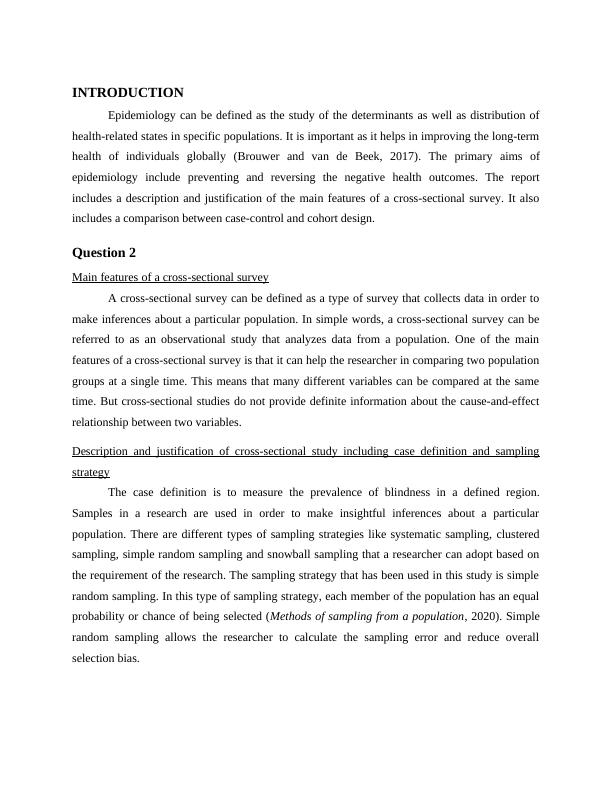Introduction to Epidemiology
Added on 2023-01-03
8 Pages2445 Words75 Views
Introduction to
Epidemiology
Epidemiology

Contents
INTRODUCTION.....................................................................................................................................3
Question 2..................................................................................................................................................3
Main features of a cross-sectional survey................................................................................................3
Description and justification of cross-sectional study including case definition and sampling strategy. .3
Data Collection........................................................................................................................................3
Potential sources of bias and procedures to reduce bias...........................................................................4
Question 3a................................................................................................................................................4
Compare and contrast case-control and cohort study designs..................................................................4
Rationale for design selection..................................................................................................................5
Define participant groups and discuss sampling......................................................................................5
Strengths and limitations of selected design............................................................................................5
Question 4a................................................................................................................................................5
Discussion of RCT design.......................................................................................................................5
Design issues in relation to this scenario.................................................................................................6
Ethical issues in relation to this scenario.................................................................................................6
Question 4b................................................................................................................................................6
Identification of a suitable alternative study design.................................................................................6
Rationale for design selection in terms of feasibility, ethics, internal validity etc...................................7
CONCLUSION..........................................................................................................................................7
REFERENCES..........................................................................................................................................8
INTRODUCTION.....................................................................................................................................3
Question 2..................................................................................................................................................3
Main features of a cross-sectional survey................................................................................................3
Description and justification of cross-sectional study including case definition and sampling strategy. .3
Data Collection........................................................................................................................................3
Potential sources of bias and procedures to reduce bias...........................................................................4
Question 3a................................................................................................................................................4
Compare and contrast case-control and cohort study designs..................................................................4
Rationale for design selection..................................................................................................................5
Define participant groups and discuss sampling......................................................................................5
Strengths and limitations of selected design............................................................................................5
Question 4a................................................................................................................................................5
Discussion of RCT design.......................................................................................................................5
Design issues in relation to this scenario.................................................................................................6
Ethical issues in relation to this scenario.................................................................................................6
Question 4b................................................................................................................................................6
Identification of a suitable alternative study design.................................................................................6
Rationale for design selection in terms of feasibility, ethics, internal validity etc...................................7
CONCLUSION..........................................................................................................................................7
REFERENCES..........................................................................................................................................8

INTRODUCTION
Epidemiology can be defined as the study of the determinants as well as distribution of
health-related states in specific populations. It is important as it helps in improving the long-term
health of individuals globally (Brouwer and van de Beek, 2017). The primary aims of
epidemiology include preventing and reversing the negative health outcomes. The report
includes a description and justification of the main features of a cross-sectional survey. It also
includes a comparison between case-control and cohort design.
Question 2
Main features of a cross-sectional survey
A cross-sectional survey can be defined as a type of survey that collects data in order to
make inferences about a particular population. In simple words, a cross-sectional survey can be
referred to as an observational study that analyzes data from a population. One of the main
features of a cross-sectional survey is that it can help the researcher in comparing two population
groups at a single time. This means that many different variables can be compared at the same
time. But cross-sectional studies do not provide definite information about the cause-and-effect
relationship between two variables.
Description and justification of cross-sectional study including case definition and sampling
strategy
The case definition is to measure the prevalence of blindness in a defined region.
Samples in a research are used in order to make insightful inferences about a particular
population. There are different types of sampling strategies like systematic sampling, clustered
sampling, simple random sampling and snowball sampling that a researcher can adopt based on
the requirement of the research. The sampling strategy that has been used in this study is simple
random sampling. In this type of sampling strategy, each member of the population has an equal
probability or chance of being selected (Methods of sampling from a population, 2020). Simple
random sampling allows the researcher to calculate the sampling error and reduce overall
selection bias.
Epidemiology can be defined as the study of the determinants as well as distribution of
health-related states in specific populations. It is important as it helps in improving the long-term
health of individuals globally (Brouwer and van de Beek, 2017). The primary aims of
epidemiology include preventing and reversing the negative health outcomes. The report
includes a description and justification of the main features of a cross-sectional survey. It also
includes a comparison between case-control and cohort design.
Question 2
Main features of a cross-sectional survey
A cross-sectional survey can be defined as a type of survey that collects data in order to
make inferences about a particular population. In simple words, a cross-sectional survey can be
referred to as an observational study that analyzes data from a population. One of the main
features of a cross-sectional survey is that it can help the researcher in comparing two population
groups at a single time. This means that many different variables can be compared at the same
time. But cross-sectional studies do not provide definite information about the cause-and-effect
relationship between two variables.
Description and justification of cross-sectional study including case definition and sampling
strategy
The case definition is to measure the prevalence of blindness in a defined region.
Samples in a research are used in order to make insightful inferences about a particular
population. There are different types of sampling strategies like systematic sampling, clustered
sampling, simple random sampling and snowball sampling that a researcher can adopt based on
the requirement of the research. The sampling strategy that has been used in this study is simple
random sampling. In this type of sampling strategy, each member of the population has an equal
probability or chance of being selected (Methods of sampling from a population, 2020). Simple
random sampling allows the researcher to calculate the sampling error and reduce overall
selection bias.

End of preview
Want to access all the pages? Upload your documents or become a member.
Related Documents
Questions on Research Designlg...
|8
|2175
|94
Research Methodologies | Descriptive Researchlg...
|7
|1758
|27
Epidemiology and Biostatisticslg...
|7
|1238
|153
Quantitative analysis of business 2022lg...
|10
|1862
|38
Pharmacoepidemiology: Types of Errors and Biaslg...
|9
|1560
|97
Epidemiology: Study Designs for Lung Cancer and Smoking, Depression and Binge Eating, Detention and Health, Folate and Autism, Alzheimer's Druglg...
|7
|1581
|367
